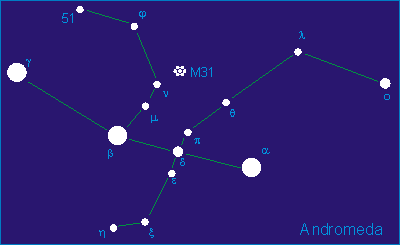Omicron Andromedae
 Location of ο Andromedae (far right) | |
| Observation data Epoch J2000 Equinox J2000 | |
|---|---|
| Constellation | Andromeda |
| Right ascension | 23h 01m 55.26459s[1] |
| Declination | +42° 19′ 33.5334″[1] |
| Apparent magnitude (V) | 3.62[2] (3.55 - 3.78[3]) |
| Characteristics | |
| Spectral type | B6III + A2[4] |
| U−B color index | -0.53[2] |
| B−V color index | -0.09[2] |
| Variable type | γ Cas[5][3] |
| Astrometry | |
| Radial velocity (Rv) | -14.0[6] km/s |
| Proper motion (μ) | RA: +22.99[1] mas/yr Dec.: +0.88[1] mas/yr |
| Parallax (π) | 4.75 ± 0.53[1] mas |
| Distance | approx. 690 ly (approx. 210 pc) |
| Absolute magnitude (MV) | −2.6[7] |
| Orbit[4] | |
| Primary | A |
| Companion | B |
| Period (P) | 159.7 years |
| Semi-major axis (a) | 0.322" (68.4 AU) |
| Eccentricity (e) | 0.55 |
| Inclination (i) | 114.7° |
| Orbit | |
| Primary | Aa |
| Companion | Ab |
| Period (P) | 8.3 years |
| Semi-major axis (a) | 0.040" (8.5 AU) |
| Eccentricity (e) | 0.55 |
| Inclination (i) | 179.9° |
| Orbit | |
| Primary | Aa1 |
| Companion | Aa2 |
| Period (P) | 33.01 days |
| Eccentricity (e) | 0.24 |
| Details | |
| ο And Aa | |
| Mass | 3.6 + 2.9[4] M☉ |
| Radius | 6.6[7] R☉ |
| Luminosity | 1,380[8] L☉ |
| Temperature | 13,800[8] K |
| Rotational velocity (v sin i) | 240[8] km/s |
| ο And Ab | |
| Mass | 2.4[4] M☉ |
| ο And B | |
| Mass | 3.6[4] M☉ |
| Age | 50.1 ± 6.8[9] Myr |
| Other designations | |
| ο And A: HD 217675 | |
| ο And B: HD 217676 | |
| Database references | |
| SIMBAD | data |
Omicron Andromedae (ο And, ο Andromedae) is a star system in the constellation Andromeda. It is approximately 692 light years from Earth.
Omicron Andromedae is a binary star, whose two components are both spectroscopic binaries themselves, making a four-star system. The system as a whole is classified as a blue-white B-type giant, with a mean combined apparent magnitude of +3.62.
The separation of the two brightest components, ο Andromedae A and ο Andromedae B, is 0.34 arcseconds. They have an orbital period of 68.6 years. A is separated from its spectroscopic companion by 0.05 arcseconds. A is a Gamma Cassiopeiae type variable star and the system's brightness varies from magnitude +3.58 to +3.78. This, in turn, has made determination the orbital period of A's spectroscopic binary difficult.[11] B's spectroscopic companion was discovered in 1989, and that binary has a period of 33.01 years.[12]
This star system has a peculiar velocity of 34.5 ± 5.9 km/s.[9]
References
- 1 2 3 4 5 van Leeuwen, F. (November 2007). "Validation of the new Hipparcos reduction". Astronomy and Astrophysics. 474 (2): 653–664. Bibcode:2007A&A...474..653V. arXiv:0708.1752
 . doi:10.1051/0004-6361:20078357.
. doi:10.1051/0004-6361:20078357. - 1 2 3 Nicolet, B. (1978), "Photoelectric photometric Catalogue of homogeneous measurements in the UBV System", Observatory, Bibcode:1978ppch.book.....N.
- 1 2 Samus, N. N.; Durlevich, O. V.; et al. (2009). "VizieR Online Data Catalog: General Catalogue of Variable Stars (Samus+ 2007-2013)". VizieR On-line Data Catalog: B/gcvs. Originally published in: 2009yCat....102025S. 1. Bibcode:2009yCat....102025S.
- 1 2 3 4 5 Olević, D.; Cvetković, Z. (2006). "Dynamical Masses of the Components in o Andromedae". The Astronomical Journal. 131 (3): 1721. Bibcode:2006AJ....131.1721O. doi:10.1086/499539.
- ↑ Zasche, P.; Wolf, M.; Hartkopf, W. I.; Svoboda, P.; Uhlař, R.; Liakos, A.; Gazeas, K. (2009). "A Catalog of Visual Double and Multiple Stars with Eclipsing Components". The Astronomical Journal. 138 (2): 664. Bibcode:2009AJ....138..664Z. arXiv:0907.5172
 . doi:10.1088/0004-6256/138/2/664.
. doi:10.1088/0004-6256/138/2/664. - ↑ Wilson, Ralph Elmer (1953), "General Catalogue of Stellar Radial Velocities", Washington, Washington: Carnegie Institution of Washington, Bibcode:1953GCRV..C......0W.
- 1 2 Underhill, A. B.; et al. (November 1979), "Effective temperatures, angular diameters, distances and linear radii for 160 O and B stars", Monthly Notices of the Royal Astronomical Society, 189 (3): 601–605, Bibcode:1979MNRAS.189..601U, doi:10.1093/mnras/189.3.601.
- 1 2 3 Balona, L. A.; Dziembowski, W. A. (October 1999), "Excitation and visibility of high-degree modes in stars", Monthly Notices of the Royal Astronomical Society, 309 (1): 221–232, Bibcode:1999MNRAS.309..221B, doi:10.1046/j.1365-8711.1999.02821.x.
- 1 2 Tetzlaff, N.; Neuhäuser, R.; Hohle, M. M. (January 2011), "A catalogue of young runaway Hipparcos stars within 3 kpc from the Sun", Monthly Notices of the Royal Astronomical Society, 410 (1): 190–200, Bibcode:2011MNRAS.410..190T, arXiv:1007.4883
 , doi:10.1111/j.1365-2966.2010.17434.x
, doi:10.1111/j.1365-2966.2010.17434.x - ↑ "omi And -- Be Star", SIMBAD Astronomical Object Database, Centre de Données astronomiques de Strasbourg, retrieved 2012-06-23.
- ↑ Olević, D.; Cvetković, Z. (March 2006), "Dynamical Masses of the Components in o Andromedae", The Astronomical Journal, 131 (3): 1721–1723, Bibcode:2006AJ....131.1721O, doi:10.1086/499539.
- ↑ Hill, G. M.; et al. (February 1988), "Omicron Andromedae is quadruple", Publications of the Astronomical Society of the Pacific, 100: 243–250, Bibcode:1988PASP..100..243H, doi:10.1086/132161.